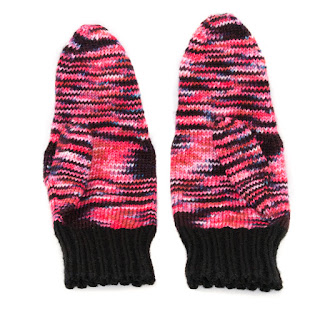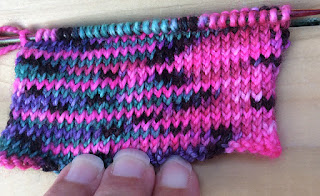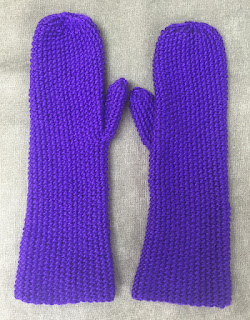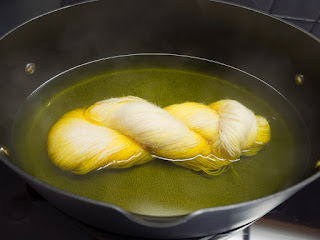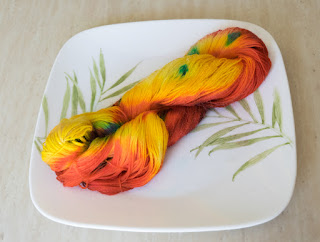What I used
- 100g Bare Opal Superwash Fingering Weight Yarn
- Americolor Super Black Food Colouring
- Citric Acid and Water Mix (1 Tbsp citric acid dissolved in 1 cup of water)
- Rachael Ray Oval Pasta Pot
- Stove
- Baby Shampoo
- Towel
I started off by soaking my yarn in plain, warm water. As I have mentioned in at least one of my previous posts, I have been told that soaking in plain water will help give a more even colour.
After the water had soaked for about 45 minutes, I removed the yarn and added the dye to the pot. I used 20 drops of the Americolor Super Black. They are not easy drops to work with, kind of thick and gloopy... but I managed to get 20 of them in the pot. I mixed well with my wire whisk and then slowly added the pre-soaked yarn.
I realized this morning that I did not add any salt to the water. Not sure if that would have made much of a difference, but I did notice that, so I wanted to point it out. Salt it supposed to slow down the bonding of the colour to the yarn, to make it a more even colour.
After the yarn was added, I turned the stove on to medium and slowly brought up to temperature. My husband came in after the yarn had been in the pot for about 10 minutes and said "Oh, you are dying a dark purple...nice". In retrospect, I almost wish I had taken the yarn out at that point, because I did like the shade I got, but I was trying for black. I might try it again later and stop at that purple stage, although I don't like to waste dye.
I did take picture during the process, but some of them may be hard to see. Trying to photograph dark yarn in a pot of dark dye with a fluorescent light above you is a little tricky....
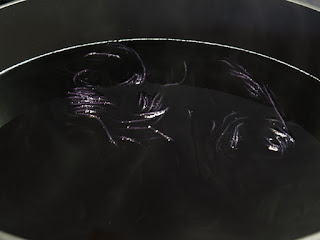 |
| After about 10 minutes in the dye as it was heating. A nice dark purple shade at this point. |
I let the yarn go for another 20 minutes or so before I added any acid. I didn't want the black to break, so I wanted to add the acid slowly. I added 1 tablespoon of my mixture and then let the yarn for for another 10 minutes before adding the second. I did this one more time, until I had three tablespoons in, then decided to leave the yarn for a while.
After another half hour or so, I came back to check on it, and it had gotten darker, but was still very much purple.
 |
| This would have been after about an hour in the dye |
I also took a picture of how the black dye "breaks" on paper towel. I had wiped off the whisk and the thermometer, and almost instantly the colours broke apart.
 |
| You can see very distinct reds/purples/blues in the dye after it touches the paper towel |
I added one or two more tablespoons of the acid mix (at that point I think it was whatever was left in the mason jar) and then turned the heat down even lower and left it for another hour or two.
 |
| How it looked before I added the last bit of acid |
I wanted to give it as much of a chance as I could to get as dark as I could, so I actually had a bit of patience this time! At some point, my husband walked by and said "That looks black now!"
It was now time to wash dry the yarn. The water had cooled completely, and all but the smallest amount of blue had struck
 |
| Almost clear dye (keep in mind, the pot is grey) |
I washed in baby shampoo, and very little colour came out. I then wrung it out on a towel and tried to take a picture. I am still getting used to my new camera, and it kept changing the exposure, but you get the idea... the "stripes" are from the curtain, they are not on the yarn.
 |
| After washing, before drying |
I could tell at this point that I had something somewhat close to the Dark Chocolate I did in my How To - Immersion Dyeing (Part One - Single Colour) post, but the colour was not as even. Which is actually how the yarn looked after the first pass of the dye with that immersion dyeing.
After drying the yarn, I could see a lot of different tones, a lot of lighter spots (even though I added the yarn to the water very carefully and slowly), and I could see hints of purple, of light grey, of a blueish tone, and in sone spot, you can even see where one fuzzy part decided to stay red.
 |
| Full skein, not quite the dark black I was going for |
 |
| You can see some of the lighter spots, and the one fuzzy the decided it only wanted to be red |
 |
| Some darker shades on the other end |
 |
| Close-up of the fuzzy....weird little guy |
 |
| When I flipped it over, this was what I saw on the back. A much lighter spot than I expected |
So this first attempt at black gave me an interesting multi-tonal shade, but did not result in black at all. It is more of a super dark purple mixed with a super dark brown.
It was not quite as brown as the other skein I did, but I think a lot of that has to do with the Ghoul Aid. When I mixed that up, there was a very distinct brown tinge to it, and I did not use that in this dye stock.
I am going to overdye it with 10 more drops of black, just to see if I can even out and maybe darken the colour. I don't expect to get black... just a bit of a more even, maybe darker colour. And I want to see what that one red fuzzy is going to do! I thought about trying another 20 drops, but the last time I overdyed the dark skein, I would up rinsing out a lot of the dye, so rather than waste dye, I am going to soak it and try a little less dye.
I will try to repeat this experiment with my new Wilton black in the pots, which is not supposed to break. I may try it with the WCR a well, although I know that one breaks, and expect it would be fairly close to the one I did with the Ghoul Aid.
Have you tried dyeing a full skein of black with food colouring? If so, how did it work out for you?


